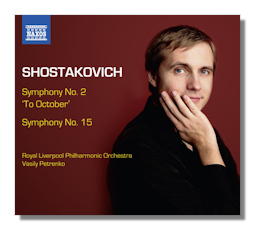
The Internet's Premier Classical Music Source
Related Links
- Shostakovich Reviews
- Latest Reviews
- More Reviews
-
By Composer
-
Collections
DVD & Blu-ray
Books
Concert Reviews
Articles/Interviews
Software
Audio
Search Amazon
Recommended Links
Site News
 CD Review
CD Review
Dmitri Shostakovich

Complete Symphonies, Volume 7
- Symphony #2 "To October", Op. 14 *
- Symphony #15, Op. 141
* Royal Liverpool Philharmonic Chorus
Royal Liverpool Philharmonic Orchestra/Vasily Petrenko
Naxos 8.572708
Any conductor taking on the challenge of a complete Shostakovich symphony cycle must grapple with the daunting task of making the most of the lesser works in the canon. Among the least successful of the fifteen symphonies is #2, an interesting piece in many ways, but ultimately a weak one. Fifty or so years ago, when I was in my teens, I actually liked this work and thought it was cool. "Cool" was, of course, a catch-all word then, and this brash but patchwork sort of symphony easily met my definition of that word. Kirill Kondrashin's Melodiya recording of the piece was very effective and worlds better than Haitink's recording of the piece, which appeared a couple of decades later. Other cyclists have done well with this problematic piece including Barshai on Brilliant Classics and Slovak on Naxos.
In his ongoing cycle of the Shostakovich symphonies Petrenko makes about the best case possible for this work. Cast in a single movement, the symphony is divided into three sections, with the thread-bare first establishing a dark atmosphere, apparently to suggest the oppression in Russia under the Tsar. The second section is very animated and violent, while the concluding panel features a chorus singing praise to the revolution and Lenin. The symphony features no particularly catchy melodies, no innovative harmonies or rhythms, and nothing else that might stand out after a hearing or two. Yet, its dark opening and slashing second section seem to promise a brave new world but fail to deliver the goods. Petrenko, however, wrenches mystery and darkness from the opening section and then goes on to impart tension and spirit to the often muddled music in the ensuing section. The choral music in the final panel is lively and somewhat brusque, more happy in character than triumphant. While Kondrashin was able to bring out more detail in his old Melodiya recording, Petrenko gives the music an edginess and sense of rawness. The performances of the Royal Liverpool Philharmonic Chorus and Orchestra are very spirited and the sound reproduction quite vivid, thus making this account competitive with the very best.
Alongside the Second Symphony, the Fifteenth comes across as a masterstroke, though it too is far from the composer's finest symphonic offering. Still, the valedictory character of the work is powerful, from the hobbled nature of joy in the first movement to the dark and puzzling character of the second, and onto the mocking and sarcasm in the ensuing Allegretto and the dark and fateful music in the finale. The Wagner quotations in the finale (from Die Walküre and Siegfried) are apparently used to tie together fate and death. Whatever the case, it must be said that the second and fourth movements can test your patience in their thread-bare instrumentation and glacial tempos. But Petrenko is effective throughout, not only because he effectively captures the sense of conflicted joy in the first movement (where Rossini's galop theme from the William Tell Overture is quoted), but in part because he refuses to move the tempos ahead in the long-winded but profound second and fourth movements, plumbing the music for all its eerie depth. That said, I will concede that some listeners may find his tempo choices a bit too deliberate. The third movement is ghostly here, not just biting and sarcastic. Again, the Royal Liverpool Philharmonic Orchestra is in fine form and all in all, this must be assessed a most compelling, if slightly controversial account of this enigmatic symphony.
Maxim Shostakovich and Kondrashin both made extremely effective recordings of this work for Melodiya in the 1970s, but I think Petrenko offers a different, more probing perspective from their leaner accounts. Moreover, because the sound reproduction is vivid and powerful, this must be counted among the more convincing performances available. Shostakovich mavens will surely want this new Naxos CD, as well as many of those interested in 20th century orchestral music in general. Petrenko is certainly a conductor to watch.
Copyright © 2012, Robert Cummings





















